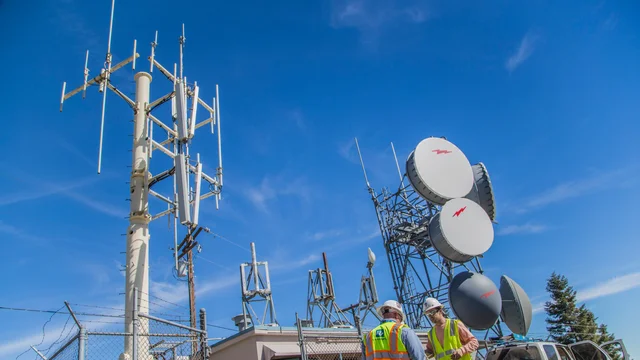
Private LTE for Utilities: The Backbone of a Resilient, Responsive, and Safer Grid

Grid resiliency begins with communications resiliency. For decades, the power grid has operated as a network of interconnected technologies. Yet without reliable communications infrastructure, this connected grid is left powerless. As the number of connected devices grows, only LTE and 5G wireless technologies offer the capacity and capability to support millions of simultaneous connections. From storm hardening and rapid response to cybersecurity and intuitive operations, every aspect of grid modernization depends on advanced communications. Today, Private LTE and 5G networks are emerging as leading solutions to meet these demands.
In a world where reliable service is non-negotiable, Private LTE delivers the performance, security, and scalability utilities need to build a smarter, stronger grid.
Southern Linc Case Study: Real-World Grid Resilience with Private LTE
Traditional utility communications systems—often a patchwork of legacy and traditional narrowband radio, leased lines, and public carrier networks—are no longer sufficient. During disasters, public networks can become congested or fail entirely, leaving utilities without the real-time visibility, control and workforce coordination they need.
That’s where Private LTE and 5G networks come in. These dedicated, utility-owned networks provide secure, high-bandwidth, low-latency communications that can remain operational even when commercial networks go down. They’re not just a nice-to-have, they’re the missing link in disaster recovery.
Southern Company, through its subsidiary Southern Linc, exemplifies the power of private LTE networks. When a major hurricane struck the southeastern U.S., the utility’s private LTE network restored services within just 72 hours—faster than local commercial carriers.
Southern Linc’s rapid restoration after Hurricane Delta wasn’t a stroke of luck—it was the result of strategic investment in utility-grade infrastructure. We were able to build our private LTE network to mission-critical standards, complete with hardened sites and backup power. This kind of resilience makes a powerful business case for utilities to own and operate their communication networks to ensure faster response, quicker service restoration and safer communities.”
Bentina Terry, president and CEO of Southern Linc.
Building the Foundation for Utility Grid Resiliency with Private LTE
For grid leaders across generation, transmission, distribution, metering and smart grid - charged with building a resilient and intelligent grid - Private LTE/5G networks are more than just a communications upgrade. They deliver high-bandwidth, low-latency capabilities essential for reliable, efficient grid performance.
Real-time grid edge control
Achieve real-time monitoring and control of grid-edge devices simultaneously - like smart meters, reclosers, and distributed energy resources (DERs). Enable instant outage detection, fault isolation and coordinated restoration to ensure safety and improve SAIDI/CAIDI performance.
Mission-critical communications
Support mission critical push to talk (MCPTT) for field force safety and mutual aid coordination with guaranteed bandwidth and reliability.
Wildfire Mitigation
Deploy IoT sensors to enhance situational awareness and speed up response times – such as falling conductor protection (FCP), which quickly detects, and locates a fault, and disconnects power from downed power lines to reduce ignition risks.
Advanced Metering Infrastructure (AMI 2.0)
Enable two-way, near real-time communication for better demand response and outage management.
Cybersecurity and Control
Gain full control over network security and data routing to ensure compliance and protect your most critical systems. Private LTE/5G delivers a full security protocol stack not available from leased or commercial carriers – reducing cyber risk and lowering cyber insurance costs.
Spectrum Strategy for Utilities: The Cornerstone of Grid Reliability
A pLTE network is only as strong as the spectrum it runs on. Choosing the right spectrum is critical to ensure coverage, performance and long-term viability. It takes a strategic approach to avoid selecting the wrong spectrum which can lead to costly sites, dead zones and stranded grid assets that underperform without the required network capacity and throughput.
Key considerations for spectrum selection:
Capacity & QoS: The lower the frequency with more spectrum the farther the signal can travel and more devices can be connected resulting in significantly fewer sites. Dedicated spectrum with higher capacity provides low-latency, clear communication, and no congestion when traffic spikes during crises. For example, In a bandwidth comparison study by Black & Veatch, a utility serving 60K square miles– including large urban areas - would need 2.5 times more sites to meet smart grid capacity and connectivity demands using 6 MHz compared to 14 MHz that 800 MHz provides. The 800 MHz spectrum’s broader bandwidth translated to over $600 million in savings over 20 years.
Interference Control: Exclusive spectrum gives full control; shared bands require careful coordination. A clear spectrum that’s ready to deploy, such as 800 MHz Band 26, will speed integration.
Device ecosystem: LTE bands with broader MCPTT device support, lowering cost and seamless implementation. Spectrum, such as 800 MHz Band 26, has a large global and extensive device ecosystem for easier procurement, more competitive pricing and quicker integration with existing P25 or LMR gear.
Interoperability: Aligning with FirstNet / public safety bands make roaming or direct interoperability possible. Band 26 also can be interoperable with LMR networks.
Longevity & Security: Purchasing spectrum secures decades of use, without the risk of reallocation or dependent on renegotiating a lease.
Explore more of our Private LTE resources
Contact Us
Looking for a partner in innovation?
Let's Talk


